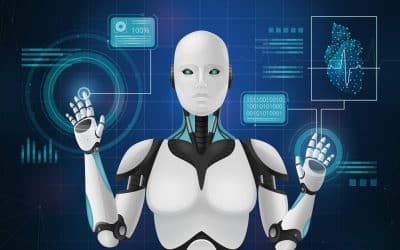Machine learning has emerged as an innovative force within software design, upending traditional models while augmenting developer and engineer abilities. Businesses constantly seek innovative methods to improve their ventures’ effectiveness, with machine learning playing an essential role. Organizations and companies are Leading this technological revolution dedicated to harnessing artificial intelligence through machine learning development services to craft sophisticated smart software solutions.
Machine learning development companies are recognized for their proficiency in using cutting-edge algorithms, data analysis, and predictive models to craft software solutions beyond programming language limitations. Their services create smart software capable of learning quickly while adapting and changing as technology changes.
As more organizations realize their competitive edge potential through machine learning solutions, there has been an upsurge in specialist organizations that can handle its complex nature – increasing demand.
This chapter explored the effects of machine learning on software development, emphasizing its vital role as an innovation driver for industries and their development companies. Herein lies our goal – we shall examine their contributions by exploring their approaches toward merging machine learning, AI, and software engineering solutions that surpass conventional programming limits.
The Intersection of Data Science and Software Engineering
The combination of software engineering and data science creates a pivotal point in the technological landscape where the combination of engineering and analytical expertise generates a synergistic power that drives technological innovation. Data science, which focuses on gaining meaningful insights from huge data sets, seamlessly combines with the fundamental foundations of software engineering, guiding the creation of adaptive and intelligent applications.
In the middle of this interplay is the power of data to transform. Data scientists work with software engineers to tap the potential of machine-learning algorithmic models, statistics, and advanced analytics.
Together, they can analyze, process, and utilize data to enhance decisions within software applications. This integration goes beyond the conventional programming models that allow applications to respond to predefined inputs and evolve and learn in response to evolving data patterns.
The close relationship between software engineering and data science can be seen in the development of advanced data-driven software. In everything from predictive analytics to recommendation systems.
The fusion of these two disciplines allows the creation of innovative solutions beyond static rules-based software’s limitations. Real-time adaptiveness, which is a key feature of this partnership, enables software to constantly enhance and improve its performance in response to changing patterns in data.
This intersection does not just alter the technical landscape but also transforms the methods of development. Agile principles, part of software engineering and data science, can facilitate an iterative development process.
This results in a dynamic and flexible approach that aligns software with the changing demands of users and new trends. The interplay between software engineering and data science creates an ideal platform for transformational technological innovation that propels the industry to a future where smart applications driven by data will transform technological innovation possibilities.
Enhancing the accuracy of software through Machine Learning Models
Improving software accuracy is essential in the ever-growing technological advancements, and incorporating machine learning models has proven to be a game changer in this quest. Machine Learning Development, at the forefront of this advancement, plays an essential role in increasing the precision and reliability of computers by using advanced algorithms and predictive models.
The Machine Learning models are created to learn from data patterns and evolve to changing conditions, providing an evolving approach to improving software accuracy. These models study vast amounts of data that reveal intricate connections and subtleties that aren’t apparent from traditional rules-based programming. Utilizing this analytical skill, machine learning development empowers software engineers to develop applications that surpass or exceed accuracy requirements.
A notable use of machine learning for software accuracy enhancement is predictive analytics. Through forecasting future trends based on the past, machine learning models allow the software to make better choices, reducing mistakes and improving outcomes. In healthcare, finance, and cybersecurity, where precision and accuracy are essential, machine learning is a significant factor in creating more efficient and reliable software solutions.
Furthermore, the continuous learning part of machine learning models guarantees that they can adapt to changing environments and improve accuracy even in unstable environments. It doesn’t matter if it’s natural language processing to help users better understand inputs or image recognition to ensure more precise visual analysis. Machine Learning Development tailors’ models to specific requirements, improving software accuracy across various applications.
The incorporation of models for machine learning through Machine Learning Development represents a fundamental shift in the quest for software’s accuracy. By harnessing the ability to learn of these models, software engineers are not just improving existing software but also paving the way to a new age of precise, intelligent, and scalable software solutions.
Machine Learning for Predictive Analytics in Code Behavior
Integrating Machine Learning into software development resulted in an era of transformation, specifically in predictive analytics to predict code behavior. This advanced use of machine learning allows developers to move beyond conventional programming models, allowing the development of smart systems that anticipate and respond to changes in the patterns of code execution.
Predictive analytics in code behavior uses machine learning models to study past code data and identify patterns and trends that inform future code behavior. This technique provides valuable insights into the potential causes of performance bottlenecks and optimizes opportunities in the software development lifecycle.
One of the most important aspects of machine learning that can be used to predict code behavior analysis is the detection of anomalies. Educating models on datasets that show normal code execution can detect anomalies that could indicate security vulnerabilities, bugs, or even subpar performance.
This proactive approach enables developers to fix issues before they appear in production, improving software reliability and reducing debugging time.
Furthermore, machine learning allows forecasting of resource usage and runtime characteristics. Developers can use these insights to optimize their code for greater performance, scalability, and resource efficiency. This proactive approach improves the user experience and the development process by reducing post-deployment problems.
Using machine learning to provide predictive analytics in code behavior significantly improves software development practices. Developers can create more reliable and efficient software through the predictive power of models that learn, which will help shape the future of software that cannot only meet the current demands but also anticipate and adjust to changing requirements.
Automation of Testing and Quality Assurance with ML
In the rapidly changing world of software development, Automated Testing and Quality Assurance (QA) are now essential processes, and the emergence of Machine Learning (ML) is changing how these tasks are carried out.
Machine Learning Development services are at the forefront of this change, using advanced algorithms to improve the effectiveness and efficiency of automation of testing as well as quality control protocols.
Machine Learning’s contribution to Automated Testing goes beyond traditional tests that are based on rules. Machine learning algorithms can analyze huge samples of test results from past tests by identifying abnormalities and patterns that human eyes could not detect.
Based on the patterns they discover, ML models can intelligently modify testing strategies, increasing the coverage and accuracy as time passes. This approach to dynamic testing is especially useful in complex software systems, where traditional testing methods are only sometimes sufficient.
Quality Assurance processes are also substantially improved by Machine Learning Development services. ML models can identify potential code areas susceptible to errors, allowing proactive steps before the software is released to production. This ability to predict defects reduces problems after release, cuts down on the time for debugging, and eventually improves the software’s overall quality.
Additionally, machine learning can aid in the development of self-healing systems. ML algorithms can identify common problems, generate automatic tests to fix these issues, and even suggest improvements to the codebase. This independence speeds up the testing process and lets developers focus on the more important aspects of design and development.
Ultimately, integrating Machine Learning Development services into Automated Testing and Quality Assurance is changing the software development industry. By integrating technology into testing processes, businesses can increase accuracy, reliability, and precision efficiency and ultimately deliver products of higher quality to the end users.
Enhancing the User Interface using Natural Language Processing
Incorporating Natural Language Processing (NLP) into software development changes how users interact with apps, especially when improving user interfaces. NLP is a subset of Artificial Intelligence focused on enabling machines to comprehend the meaning, interpret, and respond to human speech naturally and intuitively. This revolutionary technology has wide implications for designing more interactive and user-friendly application interfaces.
In the context of user interfaces, NLP allows for a more casual and easy interaction between software and users. The traditional interfaces typically require users to enter commands or input queries in certain formats, which limits users’ experience. On the contrary, NLP allows users to interact with software via natural language, making interaction more user-friendly and intuitive.
Chatbots, voice-activated assistants, and search functions based on language are some of the best examples of how NLP enhances user interfaces. By recognizing written and spoken languages, NLP enables applications to understand user intentions, respond promptly, and anticipate user needs. This doesn’t just enhance the user experience but creates new opportunities for users with varying levels of technical knowledge.
Additionally, it makes interfaces more user-friendly. NLP aids in personalization and understanding of context. Software can adapt to user preferences, language variations, and constantly changing environments, giving users a customized experience that is more personal and more engaging. This customization improves the user’s experience and helps to keep them engaged with the application.
Introducing Natural Language Processing into software development has a transformative effect in improving user interfaces. By enabling computers to comprehend and respond to natural spoken language, NLP is breaking down the barriers between technology and users and enabling interfaces that are functional but also intuitive, personal, and responsive to the various ways people use the software.
Adaptive Algorithms: Tailoring Software to User Behavior
Adaptive algorithms are an innovative method of software development in which the incorporation of machine learning (ML) development tools allows applications to adapt their interface to the user’s preferences.
These intelligent algorithms, powered through continuous analysis and learning, serve a crucial function in creating software that is not just responsive to input from users but also changes based on user preferences and patterns of usage.
ML development services allow for adaptive algorithms that use data-driven insight to determine what users do when interacting with the program. By studying patterns of behaviors, preferences, and previous usage patterns, the algorithms can implement real-time changes to the interface and features. This allows for an improved user-centric experience, which increases the user’s satisfaction and engagement.
An example of using adaptive algorithms can be seen as a part of a recommendation system. Based on continuous learning from user preferences and choices, they can recommend products, content, or features that align with each user’s preferences. This level of personalization not only enhances user experience but also helps increase the satisfaction and retention of users.
Furthermore, adaptive algorithms help enhance workflow and productivity within software applications. They can detect user behavior, improve processes, and offer contextually aware functions. This proactive approach improves productivity for users and lowers the learning curve for novice users by offering options based on their particular requirements.
Introducing adaptive algorithms via ML development tools represents an evolution in software development. Through fostering software that continuously learns and adjusts to user preferences, developers can develop software experiences that are not just functional but also flexible to user preferences, personalized, and tuned to the changing needs of the users.
Securing Security Issues Machine Learning Solutions
Security concerns in today’s technological world require creative and flexible solutions. Machine training (ML) is gaining recognition as a powerful ally for strengthening digital defense. Machine learning tools play an essential role in actively identifying and minimizing security risks and preventing them through the use of sophisticated algorithms as well as data-driven insight.
An essential use for machine learning in security would be detecting anomalies. Machine learning models can analyze huge databases, identifying regular patterns of organizational behavior. Any deviations from these patterns, which could indicate security breaches, are quickly identified. This proactive approach allows for rapid detection and response to emerging threats, thus lessening the threat of data breaches and unauthorized access.
Machine learning also plays a role in the area of intelligence on threats. By constantly analyzing and correlating huge amounts of data gathered from different sources, ML algorithms can discern patterns in known threats and identify potential attacks. This capability of prediction helps security professionals keep two steps ahead of cyber attackers, increasing the overall security of electronic systems.
Furthermore, machine learning assists in dynamic risk assessment. ML models can adapt to the changing landscape of cybersecurity, learn from emerging threats, and adapt security measures accordingly. This flexibility is essential to keep up with rapidly evolving attack techniques and the rapid growth of sophisticated cyber-security threats.
While machine learning can enhance security measures, finding vulnerabilities in ML models is crucial. Attacks by adversaries and biases in models are issues that require constant study and constant monitoring to ensure the reliability and fairness of machine-learning-based security tools.
Integrating machine-learning solutions is an innovative and dynamic approach to addressing security issues. By harnessing the power of sophisticated algorithmic techniques and analytics for data, companies can enhance their cybersecurity by staying ahead of threats and protecting valuable, sensitive digital assets in an ever-changing and interconnected digital environment.
Optimizing Resource Allocation and Code Efficiency
Optimizing the allocation of resources and the efficiency of code is an essential aspect of software development. Incorporating custom ML Model Development is a revolutionary solution to reaching these goals. This unique approach leverages the potential of machine learning to tailor models to meet the specific needs of a particular software application, enabling unimaginable levels of efficiency and optimization.
The Custom ML Model Development addresses resource allocation problems by constructing models that can be adapted to the particular demands of an application. The models can dynamically allocate resources based on actual usage patterns, maximizing the power of computation, memory, and storage to provide optimal performance. This flexibility is particularly useful in cloud computing environments where resource demands fluctuate.
Additionally, models based on machine learning can be trained to recognize and eliminate bottlenecks in code, improving execution speed and the overall efficiency of code. Through analyzing historical data and performance patterns, custom ML models can offer insights into the areas of the codebase that require improvement. This method of thinking ahead improves the development process but also aids in creating more flexible and efficient applications.
A custom ML Model Development is instrumental in predicting resource allocation as well. By predicting resource requirements using previous data and usage patterns, users can manage resources efficiently and avoid over-provisioning or under-provisioning situations. This ability to predict can result in cost savings since resources are effectively allocated to meet the demand without causing over-provisioning.
In the end, the incorporation of Custom ML Model Development into software development is a practical decision to optimize the allocation of resources and improve the efficiency of code. By adapting machine learning algorithms to meet the particular requirements of the system, developers can create an ideal balance between resource usage and efficiency of computation, eventually offering cost-effective, high-performance software solutions.
Real-time Decision-Making: Machine Learning in Action
Real-time decision-making is a crucial element of today’s software applications. The use of machine learning (ML) is revolutionizing this process. The algorithms for machine learning, along with the ability to quickly analyze huge amounts of data and provide information, help applications make intelligent decisions within the quick blink of an eye. Increasing agility and responsiveness across a range of areas.
A prominent use of machine learning for real-time decision-making is in transactions in the financial sector. Fraud detection systems use ML algorithms to study real-time transactions, rapidly detecting anomalies and taking immediate action to stop fraudulent transactions. This is not just a way to protect financial assets but also improves the security of all transactions on the internet.
In healthcare, machine learning aids in real-time diagnostics or patient care decision-making. Machine learning algorithms can analyze data streams from medical devices, interpret diagnostic images, and even predict patient outcomes by monitoring continuously. This proactive approach allows healthcare professionals to make timely decisions, enhance patient outcomes, and speed up response times in urgent circumstances.
Furthermore, in the field of service to customers, machine learning allows applications to make instantaneous decisions in response to user interaction. Chatbots and virtual assistants powered by ML models can recognize user requests, analyze the context of information, and give immediate and appropriate responses. This improves user experience by providing customized and efficient interactions even in highly complex and constantly changing situations.
Incorporating machine learning into real-time decision-making is a paradigm shift, allowing software to adapt, learn, and behave independently. As the ML algorithms continue to improve and improve, the capabilities of real-time decision-making will grow further in various industries and change the nature of flexible and responsive software applications.
The Role of Neural Networks in Software Innovation
Neural networks, a key part of artificial intelligence, play an integral part in driving innovation in software, and the knowledge provided through the Custom Machine Learning Development Company is increasingly sought-after for developing its capabilities. These complex systems, influenced by the structure of the human brain and its functioning, are revolutionizing software capabilities, allowing applications to adapt, learn, and develop in unimaginable ways.
A custom machine learning development company specializes in adjusting neural networks to the particular requirements of software applications. Neural networks are adept at recognizing patterns, processing large datasets, and making complex decisions, making them indispensable for tasks like speech and image recognition, natural language processing, and even predictive analytics.
Neural networks play an essential role in software development in areas like recommendation systems. By learning users’ preferences and patterns, they can offer highly customized suggestions, contributing to a more enjoyable and user-centered experience. In addition, neural networks enable technological advancements in autonomous systems that allow software to navigate and make decisions in various real-world, complex environments.
In addition, in the field of security software, neural networks excel at the detection of anomalies. In learning the normal behavior of an application, these networks can identify changes that could be a sign of security threats, which can lead to an enhanced and resilient defense against cyberattacks.
The ability to learn and adaptability of neural networks drive software innovations into unexplored territories. With more and more industries recognizing the power of these new technologies, a partnership with a custom machine learning development company is crucial in harnessing the neural networks to design intelligent, modern, creative, and future-ready software solutions.
Machine Learning for Anomaly Detection in Software Systems
Machine Learning (ML) is becoming a game changer in anomaly detection in software systems. It provides an adaptive and proactive approach to spot irregularities that could indicate security risks, performance issues, or unusual behavior. The primary benefit of ML in detecting anomalies is its capacity to learn and comprehend normal patterns of behavior, which allows it to discern the most significant irregularities that could indicate anomalies.
In the system of software, detecting anomalies using machine learning requires creating algorithms based on data from the past to detect the system’s normal behavior under normal circumstances. After training, the models can continuously examine the data received in real time and identify patterns that diverge from the norm.
One of the most important applications that ML can help with is anomaly detection. This is the cybersecurity field. Machine learning models can quickly detect patterns that may indicate a security breach or unauthorized access by studying the network’s traffic patterns, user behavior, or system logs. This proactive approach permits immediate mitigation and response to minimize the risk of potential risks.
Apart from security, using ML to power anomaly detection can be beneficial in optimizing software performance. Through analyzing metrics like the time to respond, resources used, and errors, these models can identify anomalies that could indicate problems with performance or bottlenecks. This allows developers to fix possible issues before they affect the user experience and overall system performance.
In conclusion, using machine learning for anomaly detection is an entirely new way to monitor and secure computer systems. The ability of ML to adapt autonomously to the changing environment and recognize any deviation from the normal pattern makes ML a vital instrument to ensure the security as well as the reliability and efficiency of computer systems changing technological trends.
Collaborative Development: ML in Version Control and Collaboration Tools
Collaboration in development, a key element in modern software engineering, is going through a radical transformation by integrating machine learning (ML) into collaboration and version control tools. This synergy doesn’t just improve the development process but also boosts team collaboration efficiency and the quality of code.
In systems for managing version control that use machine learning, algorithms look at historical changes to code commit messages, commit messages, and interactions between teams to provide an intelligent perspective.
For example, ML models can predict the possibility of code conflicts and suggest the most efficient methods of branching based on previous patterns, helping developers make better-informed decisions throughout their development. This proactive approach lowers the risk of conflicts and creates a more enjoyable collaborative code experience.
Additionally, machine learning contributes to reviewing code by automating certain aspects. Machine learning algorithms can analyze codes, detect flaws or inconsistencies, and recommend improvements. This enhancement of code review using machine learning increases the review process’s effectiveness, allowing developers to concentrate on more advanced factors of quality and structure.
Collaboration tools can also benefit from ML integration, as they efficiently assist with project management and communication. Machine learning algorithms can analyze team interactions, spot bottlenecks, and even forecast the timeline of projects based on historical information. This ability to predict the future lets teams anticipate problems, allocate resources responsibly, and improve collaboration to ensure better project execution.
Introducing machine learning in collaboration and version control tools will lead to more efficient and flexible development methods. Utilizing the patterns and data from previous years, ML empowers development teams to work seamlessly, spot possible issues ahead of time, and enhance overall efficiency and quality collaboration in software design.
Exploring the Ethical Dimensions of ML-Driven Software Development
The introduction of machine learning (ML) in software development has led to technological advances and a tangled set of ethical issues that require careful investigation. As the ML-driven development of software grows more prevalent, everyone is wrestling with privacy, bias, transparency, accountability, and the potential social implications of this technology.
A moral aspect is the transparent and responsible usage of data from users. The ML algorithms rely heavily on large databases for training and generating concerns over users’ privacy and consent. Developers must strike a delicate balance between extracting useful information from data while protecting user rights, requiring solid data governance practices and open communication with users about the use of data.
The presence of bias within ML models is a further ethical issue. ML a, algorithms can create and worsen the biases if the training data is biased or has societal biases. Developers need to use fairness-aware strategies to regularly review models to identify biases and prioritize inclusion and diversity in data curation to reduce the effect of biases on the software’s performance.
Accountability and transparency are essential ethical issues in developing ML software. Knowing how algorithms make decisions while ensuring clear communication with users and creating ways to hold them accountable when mistakes occur are crucial to keeping users’ trust and maintaining ethical standards.
Since ML technology significantly influences decision-making processes, it is essential to participate in interdisciplinary discussions involving ethicists, policymakers, and technologists to develop ethical guidelines and frameworks. Achieving a balance between creativity and ethical responsibilities is crucial to ensure that software driven by ML development is compatible with society’s values and protects the rights and well-being of people.
The Key Takeaway
Ultimately, machine learning in custom software development has led to an era of transformation, resulting in applications that can learn, adjust, and evolve. From improving user interfaces to optimizing the allocation of resources and even addressing security issues, machine learning has been an integral part of technological advancement. The ethical issues that accompany this development highlight the necessity of ethical development practices that emphasize transparency, fairness, and users’ privacy.
As the need for smart and custom-made solutions grows, the experience of a Custom AI/Machine-Learning Solutions provider becomes essential. These services provide a custom method of tailoring machine learning models to meet specific software requirements. In the ever-changing world of technology, the fusion of the human mind and machine learning capabilities allows for creative, efficient, ethical, and effective software solutions that continue pushing the limits of technological advancement.











